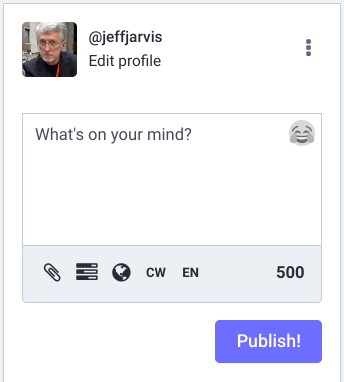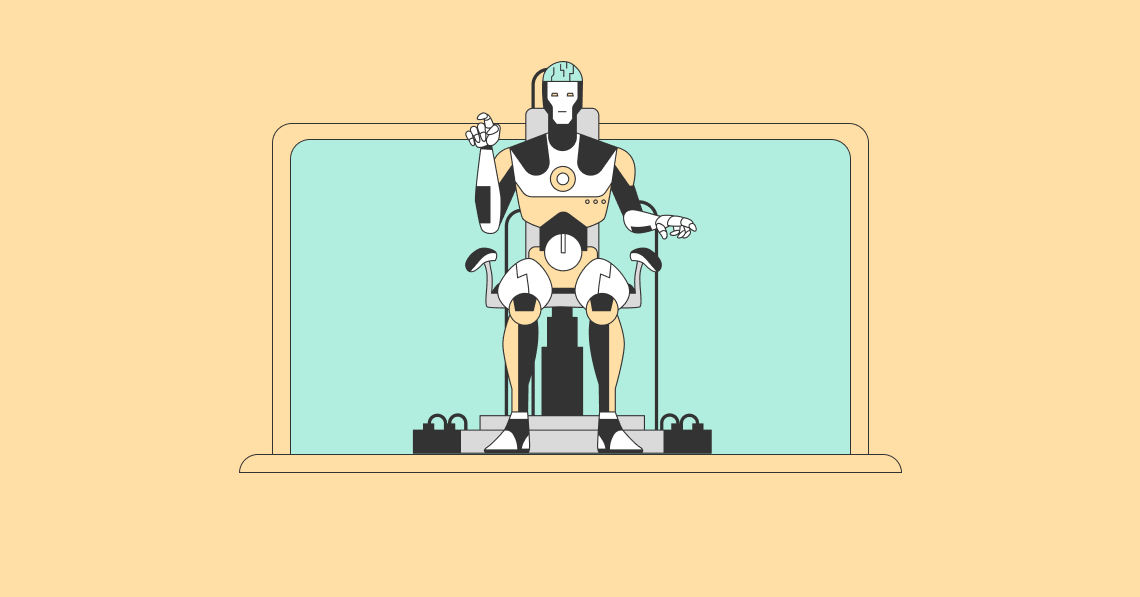

An academic friend asked for help joining Mastodon. I wrote a detailed email in response that I thought it might be useful to others. I’m also going to teach a master class in Mastodon at my school on Dec. 5 — much interest, I’m told — so here is my preparation on the practical stuff. (I will also talk that day about the implications of federation on journalism and of affordances on communities such as Black Twitter.) Keep in mind that I am a newbie, so please correct me where where I stray.
It will be a pleasure to welcome you to the new neighborhood. I’m quite liking it already. Once you arrive, you’ll find it familiar enough: You have a home timeline, a feed of just the people you follow, but with no algorithmic promotion, no ads. You can write posts (the verb to “toot” has, mercifully, become to “publish”) and boost others’ posts (AKA retweet) and reply to posts. You will receive notifications when people respond to you, boost your posts, and follow you.
You cannot quote-tweet posts as of now because of the founder’s belief that this affordance leads to performative over conversational behavior. That contention is being contested by people from Black Twitter, who use quote tweets for their call-and-response culture. Dr. Johnathan Flowers is forceful and instructive on the topic. Lately, Eugen Rochko, (@gargron), Mastodon’s founder, has softened and said he open to discussion. Developers are making suggestions for how to make QTs work (which is the beauty of this open-source project; change is emergent).
The two things that befuddle people getting started are how to pick an instance or server to join and then how to find folks. Mastodon is actually a few thousand servers — or instances, in the parlance — that each run versions of the same software and are all connected or federated in what is called the Fediverse, using an open-source protocol called ActivityPub. Every instance is independently run but can connect to any or all of the other instances, allowing you to connect with anyone on them. Not all of them are Mastodon; there are, for example, other servers for a photo-based social network called Pixelfed. No one owns this; no one can. That is the value of open source and federation. (Here is a post I wrote that examines and explains some of the implications and opportunities of federation.)
It doesn’t greatly matter what server you join as in this federated ecosystem, you can follow and converse with anyone on any server (except those that your host blocks; for example, the far-right, noxious Gab is blocked by most). Each server has its own rules. I am on mastodon.social, which is the biggest and is run by Eugen (@gargron).
If you prefer to be among academics, you might look to join hcommons.social for humanities scholars (though it is temporarily closed to new members until they catch up to the flood) or zirk.us for arts and humanities, where I see lots of smart folks, or perhaps religion.masto.host. Here’s a list of alternatives from the Humanities commons and here is very good reference that lists academic servers. You can go to any server address and add explore — e.g., zirk.us/about — to learn more about the server: who runs it, what its rules are. For journalists, we at Tow-Knight are supporting Adam Davidson as he launches journa.host. There’s another called newsie.social. Note that various news organizations — including Rest of World, Texas Observer, and San Francisco Standard — are starting their own servers for their own newsrooms.My fellow geeks might want to join Leo Laporte’s twit.social; to manage the onslaught he is now restricting it to members of his club.
Don’t stress about the choice; just pick one and go with it.
The only real implications of joining a particular server are (1) that you can view a “local” timeline populated with the posts of all the people from that server and you might find that useful , and (2) you want a responsible host who is going to block the bad guys and moderate wisely. If once on Mastodon you find the grass greener on someone else’s server, you can take your identity and your followers and go there — that portability and interoperability is a key benefit and differentiation of the federated vs. the corporate and centralized internet. Keep in mind that the content you create on your first server stays there.
OK, to get started. Go to one of the addresses above, say zirk.us. Click sign up and you’ll be shown the rules of the house, and then pick your name and such. You’re in.
I strongly recommend that you first take the time to fill in your profile with information about you, with your photo, for as soon as you start following people, they will want to know who you are and follow you back if relevant. I find it frustrating to have folks following me without letting me know who they are. It is also recommended that you write an introduction post and pin that to the top of your profile. (If you have a blog or site of your own, you can connect the two so that readers can know you are who you say ou are by using the rel=“me” markup, but that’s a graduate-level course I’ll leave that for another day.)
You will start using the web interface for Mastodon. It’s good, though I have a few key recommendations. Go to the settings (the little gear icon on top left) and under preferences/appearance I strongly suggest selecting advanced web interface. This will look like Tweetdeck. I happen to hate dark mode in all instances, but on Mastodon, it’s particularly hard to adjust to, so I urge you to try light mode.
Now to the next challenge: following people, for until you find folks to follow, you will hear only silence. One way to start is to search for folks you know are on Mastodon and see whom they follow.
Mastodon provides another fantastic way to get a starter kit: Under settings, import and export, click on import and here you can upload lists of folks to follow. For my friend to whom I wrote a version of this email, a book historian, I provided a list of book historians someone has compiled and a list of folks from my Book History Wonks Twitter list. Here is a wonderful list of lists of academics by discipline. Here is an incredibly long list of more than a thousand journalists on Mastodon (unless a masochist for hot takes, I would not suggest uploading them all).
Some of these provide a ready-made CSV to import. If not, copy just the column of Mastodon addresses into a new spreadsheet and save as a CSV. Upload the CSV file into Mastodon under settings/upload (you want to check the merge option). Voilà, you have new friends.
If you wish, you can use debirdify or fedifinder to check your own followers on Twitter for accounts that have Mastodon addresses. Click “search followed accounts” and it will produce a list and a CSV file. Since more and more folks are doing this, you will probably want to go back to your Twitter profile and add your new, forwarding address. My address, for example, is @[email protected].
By the way, Mastodon does not have a good, full-text search — on purpose (for they also believe that that enables trolls to find their targets). But you can search for names, Mastodon addresses, and hashtags.
Now let’s explore the advanced web interface for Mastodon.
The second column from the left is the most important: your home timeline. This, again, is just the people you follow in reverse-chronological order; no algo, no ads.

The third column is notifications. Once you get your sea legs, click on the settings icon on the top right of the column (the three lines) and you’ll find a plethora of choices for what notifications to receive or not: new followers, posts that mention you, replies to you, and so on. While you’re here, I recommend turning OFF sound on each one; the blips can be quite annoying. Note the subtle blue bar on the left; this is just what is new since you last read the column. (You can click the check atop the column to mark all as read.)**
Now to the first column. Here you can search for names. You can also search for hashtags; that is how people gather around topics and conversations on Mastodon. I have to get back into the habit of using hashtags in my posts. If you find a hashtag very useful, you can pin it as a column that will always appear.

Click the icon with a head and many arms and you will get your “local” timeline in another column. This is just people on your server, whether you follow them or not. Depending on the server you choose, it can seem useful or random. In the setting for this column, you can choose to pin and always show it, or not. The globe icon will open a new column called the “federated” timeline, which is a collection of everything from everyone that all the folks on your server boost on other servers. It can be a firehose. You may also choose to pin or not pin this. Thus far, I don’t use the local or federated timelines much but you might like them as a way to discover serendipitous conversations and people.

Now click on the hamburger menu on the upper left of the first column. If it is not already open, this will open the “getting started” menu with lots of offerings: direct messages to you (with the caution that direct messages are not encrypted so don’t go sharing your innermost secrets here); posts you have bookmarked (I find this handy), posts you have favorited (“liked” in Twitter parlance), lists you create, follow requests (NB this is *just* the follow requests Mastodon thinks might be suspicious; you will find all your follow requests in the notifications column). Note also that you can create lists of accounts you want to read regularly — I use that feature frequently on Twitter — but unfortunately, they are private and cannot be shared. Instead, there are groups. See some examples on the academic on mastodon page.
Click #Explore and you see four nice features: Posts are posts that are popular from across the fediverse. Hashtags are stats on the trending hashtags. News is an ok list of media stories getting links. And for you are recommendations for folks to follow; I find it of limited utility.
Now, finally, to the important part: writing. In that first column, you’ll find the box for that purpose. On most Mastodon instances, the character limit is 500 — generous next to Twitter’s 140 then 280. Some servers up that to 1,000; I have so far resisted the temptation to migrate there.
Here you can add a poll and mark the post’s language. By the way, translation works pretty well; I follow people in many languages as a result.
Mastodon has many norms built up since 2016. Norms being norms, these are likely to evolve as new people arrive wanting change and veterans resist that change; such is society.

One strong norm is that when you upload an image (with the paperclip in the posting box) you are expected to click “edit” and add alt text for accessibility. I was scolded once for not doing so and now I do it.

Another set of norms revolve around the content warning. When posting, click on the CW in the creation box and you can write a small headline others will see with the option to reveal the rest of your post — or not. This was intended to mask triggering or offensive content, important because Mastodon from its start has served vulnerable communities. However, some have extended this norm to contend that the content warning should be used for political posts. Others — especially people of color — insist (rightly, I think) that we should not hide the realities of life behind this veil. How you use it or not is up to you.
Some folks prefer other interfaces for Mastodon on the web and mobile. I’m odd — Chrome OS and Android — so I can’t speak to those for Mac and Windows and IOS.
The ethos of Mastodon, I find, is friendly, polite, curious, open, caring, decent. There will be bad apples in any orchard. Block them. Report them if they’re bad enough. There are more than enough smart people here with whom to have enjoyable, informative, and provocative conversations without the trolls Elon is nurturing in the Other Place.
Keep in mind that nearly everything you do on Mastodon is thanks to the volunteers who run servers and moderate activity there. They are humans, not algorithms. They, like algorithms, will make mistakes. Give them a break.
And give them money. Every server is likely to have a link to a place to give money to the host to pay for very real technology bills. You have left the land of corporatized, centralized, controlled conversation. It’s a new and exciting world. Help support it.
**New tip, thanks to my new Mastodon friend, Maxi5X, who pointed me to the notifications setting for the quick filter bar. That’s the menu bar atop the column. Set the second choice to display all categories…

And this is what appears:

That way, you can get notifications just for mentions, favorites, boosts, poll results, and new followers.
That little house icon takes you to another feature I didn’t mention: When you follow someone, next to the follow button is a bell. Click on that and you will be notified whenever that person posts. Thus I see whenever Eugen and my son — and Mike Masnick — post. Cool.




